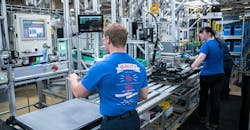AI-Based Action Recognition Technology Reaps Rewards
Mobility supplier DENSO is working with Drishti Technologies, Inc. to help optimize manufacturing production within its North American facilities. Drishti’s AI-enabled action recognition technology allows DENSO to generate real-time, continuous analytics on manual tasks performed by its production employees. This dataset grants production management the ability to quickly identify and eliminate bottlenecks, improve processes, boost efficiency and prioritize tasks.
“Action recognition technology provides real-time insights into our fundamental and human-driven production tasks: managing cycle-time variance; identifying bottlenecks in the process; ensuring that employees perform standard work every cycle; and pace setting,” Raja Shembekar, vice president of DENSO North American Production Innovation Center tells IndustryWeek. “DENSO then leverages the insights from each area to find problems and successes to make improvements, resulting in better quality and efficiency.”
Although manufacturing automation in advanced economies like the U.S. and Japan continues to increase, it is still expected to perform less than 25% of manufacturing tasks by 2025 (Boston Consulting Group, 2015), explains Shembekar.
“This means humans will execute a significant portion of manufacturing operations for years to come. With AI (neural networks) and action recognition technology, we are now able to, for the first time, get analytical and quantitative insights into the performance of manual operations, in real-time and continuously,” he says. “As a result, DENSO can dramatically increase the speed at which it implements Kaizen or continuous improvement, principles.”
These capabilities increase production outputs, improve product quality and consistency, and assist production employees in their day-to-day assignments, helping them identify how they and their teams can better streamline processes. The move is part of DENSO’s Long-Term Policy 2030 to create and inspire new value for advanced mobility using disruptive technology. It also marks one of the first times DENSO has integrated AI into its production processes.
Understanding opportunities
As Drishti discovered in joint research with A.T. Kearney, human line employees perform 72% of factory tasks. This data, from a survey of more than 100 manufacturing leaders, suggests that even as the industry increasingly focuses on robotics and Industrial Internet of Things (IIoT), people and their ingenuity remain central to manufacturing.
“True digital transformation efforts have to extend to the human operator, because the bulk of manufacturing tasks are still done manually,” said Prasad Akella, founder and chief executive officer of Drishti. “DENSO recognized that fact well ahead of the rest of the market, and our technology is helping the company secure its position as an innovation leader in the advanced automotive manufacturing industry.”
According to Shembekar, the potential DENSO now sees to achieve significant process gains while simultaneously helping our workforce add greater value is precisely why it is so committed to exploring and implementing innovation with leading-edge startups like Drishti.
"Digitizing highly variable human motion continuously and in real time provides analytics insight that can significantly improve productivity, efficiency, and quality, as well as how we approach employee training," said Jon Ruge, a director of DENSO Industrial Engineering.
Overcoming obstacles
As with any change, implementing this technology has its share of challenges. According to Shembekar, the first challenge is to get buy-in from the line worker whose action is being recorded. “We do this by explaining the technology and its purpose to them so they can clearly understand the benefit it provides them, and not just to management,” he says. “It’s especially important that we emphasize this is a supplemental technology, one that helps employees and their teams do their jobs better and smarter, rather than replace them.”
Secondly, it is vital that the action recognition technology’s accuracy is very high (> 99%), so that the analytics it provides are credible. “If the accuracy were low, employees would disregard it very quickly,” says Shembekar. “Also, the speed of the action recognition technology has to match the actual speed of production, so that there is no data lag. If there were a lag, it would have adverse impacts on productivity rather than improve it.”
Finally, the cost of such technology should be at such a price point that it provides a reasonable benefit year over year. “In other words, the benefit of human-driven production and the technology should be larger than if the process were automated,” he says.
Bottom line
“As DENSO continues to transform into a true digital operation, having data on manual tasks fills a major gap in our analytics,” says Dave Grimmer, a senior vice president at DENSO and head of its North American Production Innovation Center. “Drishti’s continuous data creation offers productivity insights and quality metrics that help us make better decisions, faster.”
Drishti’s technology produces datasets that are several orders of magnitude larger than those produced by traditional time and motion studies. Drishti-produced datasets are also more diverse and enriched by video. The benefits of these massive datasets extend beyond the production floor to DENSO’s leadership and engineers, who, like production teams, use Drishti’s technology to gather production feedback and make data-driven decisions on design and organizational management.
About the Author
Peter Fretty
Technology Editor
As a highly experienced journalist, Peter Fretty regularly covers advances in manufacturing, information technology, and software. He has written thousands of feature articles, cover stories, and white papers for an assortment of trade journals, business publications, and consumer magazines.
